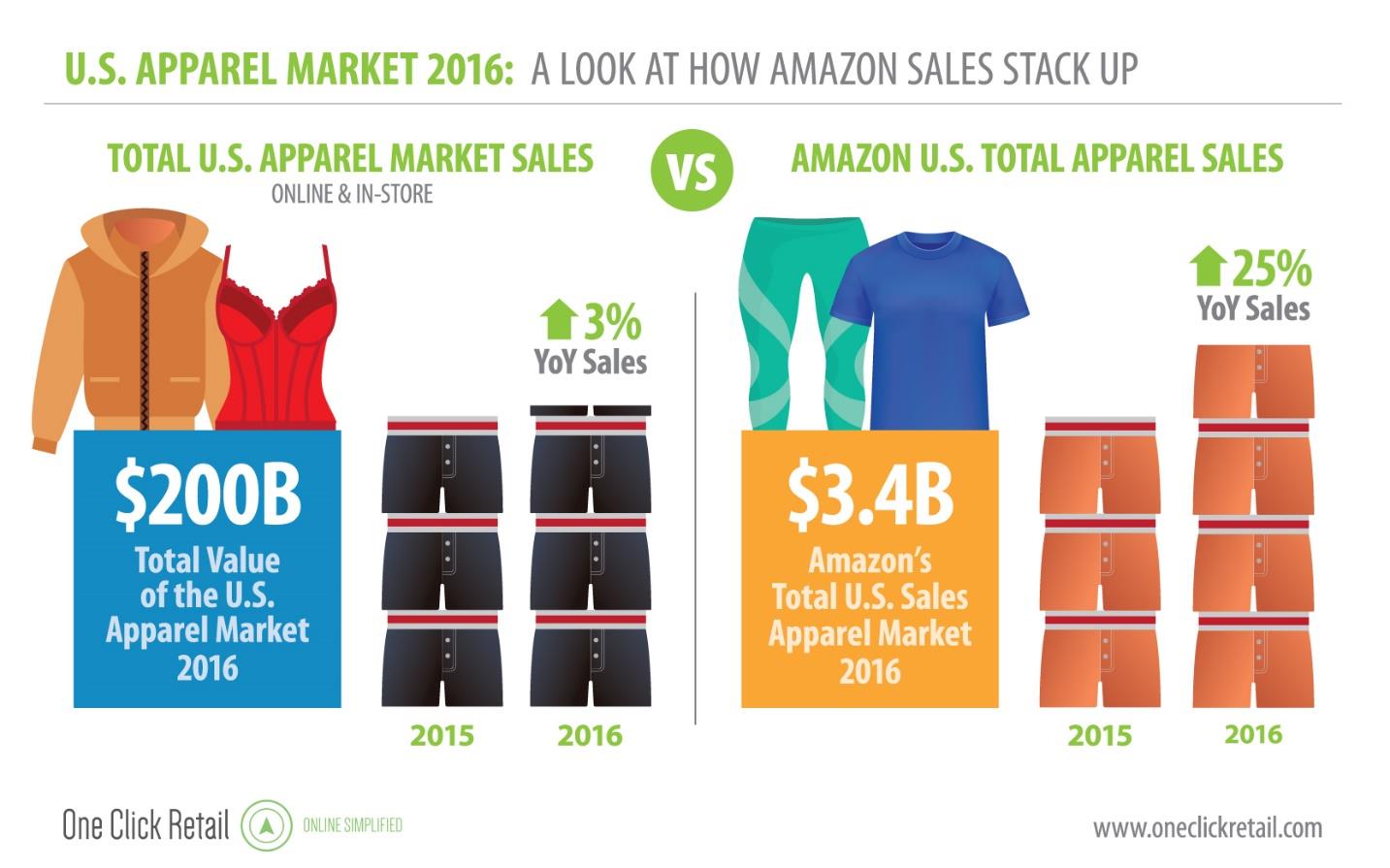Women who feel “awkward” buying bras and underwear at brick-and-mortar retailers are now ringing up their lingerie purchases online instead, and this is helping Amazon gain coveted market share, a new report from sales analytics firm One Click Retail has found.
The so-called Amazon effect is striking again, and this time in the clothing department.
As the internet giant has tackled categories such as electronics, entertainment, books, and most recently grocery — by way of a pending deal with Whole Foods — Amazon has been low-key beefing up its apparel offerings.
In 2016, the total value of the U.S. apparel market — both online and offline — was $200 billion, with Amazon claiming about $3.4 billion of that, One Click Retail said. While total U.S. apparel sales climbed 3 percent last year, Amazon’s apparel sales in the U.S. saw a 25 percent increase over the same period.
The top performing apparel categories on Amazon.com in 2016 included men’s bottoms, which pulled in $375 million in sales; women’s intimate apparel, which boasted $250 million in sales; women’s denim, with revenue of $170 million; and men’s underwear, with sales of $165 million, according to data from One Click Retail.
A representative from Amazon didn’t immediately respond to CNBC’s request for comment on these figures.

Amazon’s third annual Prime Day event this week will be the perfect opportunity for the e-retailer to promote itself more in the fashion department, Kantar Retail analyst Meaghan Werle told CNBC.
She said she’ll be watching for Amazon to “leverage the visibility of its private-label brands, especially in fashion.” Amazon could do a lot more there, Werle added.
In Amazon’s “sneak peak” of Prime Day deals, the company said its Prime Exclusive clothing, handbags and more, would be 40 percent to 50 percent off. Prime members can also save 30 percent on select clothing, shoes and more for men, women, kids and in the baby department, Amazon said.
In the spring, Amazon introduced Simple Joys by Carter’s, a line of children’s clothing sold in bundles; the Carter’s company designed this line to sell exclusively to Amazon and its Prime members.
Prior to this Amazon was selling its own private-label clothing brands, but they were hardly being marketed online. Thus far, Amazon’s so-called bread and butter when it comes to apparel has been more “everyday essentials” and not as much luxury.
“Our data shows that the company is having great success with necessities and everyday items such as jeans, socks, underwear and men’s work clothes,” One Click Retail’s report said.
Though, “in their efforts toward a hassle-free shopping experience, Amazon is investing in innovation: in payments, order fulfillment, product selection and now, with Amazon Prime Wardrobe, return policy flexibility.”
One of those efforts to ease the shopping experience is a test it’s doing of Prime Wardrobe, a new fashion platform looks similar to other wardrobe subscription services like Stitch Fix and Trunk Club. According to Amazon’s website, Prime Wardrobe includes brands outside of Amazon’s private labels, for example, Adidas, Calvin Klein, Levi’s and Hugo Boss. The service allows customers to order items like shoes, clothes or accessories at no upfront charge, only paying for what they decide to keep. Shoppers have seven days to decide what they don’t want.
And it’s possible that Amazon’s reach in the market for clothing will extend to the physical world. After the Whole Foods acquisition was announced, some analysts began floating the idea of Amazon looking to buy specialty apparel retailers next, for example Luluemon.
One reason Amazon might look to make a real-estate heavy acquisition in the future: department stores, discount stores and specialty stores remain the top store formats where women shop most often for clothes, according to a recent research report from Fung Global Retail & Technology.
Meantime, a whole host of specialty retailers have filed for Chapter 11 bankruptcy protection this year alone, including clothing brands The Limited, Wet Seal, BCBG Max Azria, Rue21, Gymboree and just last week True Religion.
There’s no reason to suspect Amazon couldn’t be a buyer of one of these apparel retailers looking to sell, either, Josh Sussberg, a partner of Kirkland & Ellis’ restructuring group, told CNBC.
“I think that every retail company is looking at their economies of scale — whether or not they have liquidity or upcoming maturities — and all of these companies are trying to figure out how to adapt to an ever-changing environment.”
Amazon is now “eating the retail world,” MKM Partners analyst Rob Sanderson wrote in a note to clients last week.
It’s important to note that Amazon still only boasts a 5 percent share of total retail sales, excluding food, across the country, according to data from the U.S. Census Bureau. But Amazon’s share of retail sales across the U.S. in key categories — sporting goods, clothing, personal care and electronics — will only continue to accelerate from here, Sanderson said.
By Monday, shares of Amazon have climbed nearly 34 percent over the past 12 months, and the stock was seen hovering right below the $1,000 mark ahead of Prime Day.
Source: Tech CNBC
The Amazon effect is hitting the apparel industry